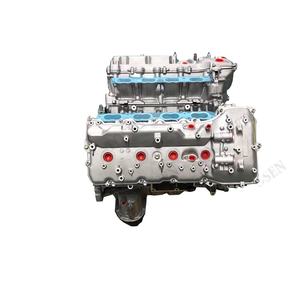Reliable and Powerful Little Automobile Motor Efficiency Analysis
Examining the efficiency of tiny car motors is a nuanced task that needs an eager eye for information and a deep understanding of auto engineering principles. By analyzing crucial metrics such as horse power and torque, as well as reviewing gas performance, we can uncover insights into how little cars and truck engines can be maximized for peak efficiency.

Small Automobile Electric Motor Efficiency Metrics
In analyzing the efficiency of tiny vehicle motors, essential metrics such as acceleration, fuel effectiveness, and power outcome play a vital duty in establishing their total performance and viability for various driving problems. Velocity, determined in secs from 0 to 60 miles per hour, suggests exactly how rapidly a little automobile can reach higher speeds, which is important for merging onto highways or surpassing various other automobiles. Fuel efficiency, generally measured in miles per gallon (MPG), reflects just how much a little cars and truck can travel on a gallon of gas, influencing running expenses and environmental sustainability. Power output, shared in horse power (HP) or kilowatts (kW), symbolizes the engine's capability to produce the needed force to move the vehicle, affecting its performance in different roadway problems. By examining these efficiency metrics comprehensively, suppliers, vehicle drivers, and automotive enthusiasts can make informed decisions concerning the choice and optimization of tiny auto electric motors to satisfy their specific demands and choices.

Horsepower and Torque Analysis
With an essential function in comprehending small vehicle motor performance, torque and horsepower analysis gives understanding into the engine's power delivery characteristics. In the context of tiny cars and truck motors, horsepower is vital for establishing velocity, top rate, and general performance. By understanding the partnership between horse power and torque, vehicle engineers can maximize engine efficiency to satisfy the particular requirements of little automobile applications.
Fuel Performance Assessment
The evaluation of gas efficiency in tiny automobile motors plays a crucial duty in determining their ecological and economic effect. Gas effectiveness describes the ability of a lorry to utilize gas efficiently in connection with the distance took a trip. In small automobile electric motors, where compact dimension often associates with far better fuel economic situation, different elements affect efficiency. Engine style, weight, the rules of aerodynamics, and driving conditions all contribute to exactly how successfully fuel is taken in.
Little automobile motors that achieve greater MPG rankings are thought about much more fuel-efficient, resulting in cost savings for chauffeurs and minimized exhausts that profit the environment. Makers continuously strive to improve fuel effectiveness via innovations in engine innovation, lightweight materials, and wind resistant styles.

Optimizing Little Auto Engine Performance
Enhancing the efficiency of little car engines is vital in making the most of efficiency and minimizing functional expenses. Enhancing small cars and truck engine efficiency involves a holistic method that considers numerous elements such as engine layout, fuel administration systems, and overall car dynamics.
Another important factor in optimizing little vehicle engine efficiency is the use of advanced modern technologies such as turbocharging or hybrid systems. These technologies can next enhance power output without endangering fuel performance, offering an equilibrium between efficiency and economy. Optimizing engine performance additionally involves improving combustion efficiency, minimizing frictional losses, and boosting thermal management systems.
Future Trends in Small Auto Motors
Because of progressing auto technologies and the constant search of optimum small automobile engine efficiency, an exploration of future trends in little auto motors ends up being imperative - opel corsa engine. One popular pattern imminent is the increasing combination of electric powertrains in tiny vehicles. As the vehicle sector changes in the direction of sustainability and reduced emissions, more little cars and truck suppliers are spending in electrical motor modern technology to boost performance and ecological kindness
An additional considerable pattern is the growth of smaller yet much more powerful turbocharged engines for little autos. By downsizing engine abilities and integrating turbocharging innovation, car manufacturers can attain higher power outcomes while keeping fuel effectiveness. This pattern lines up with the growing consumer demand for tiny cars that supply a dynamic driving experience without compromising on fuel economy.
Moreover, the emergence of crossbreed powertrains in tiny cars and trucks is anticipated to acquire traction in the future. Hybrid systems supply the advantages of both interior combustion engines and electrical motors, supplying enhanced performance and gas performance. As advancements in battery technology proceed, little automobile motors are most likely to end up being even extra reliable and powerful, satisfying the advancing demands of customers and regulatory needs for cleaner transportation solutions.
Verdict
Finally, the analysis of little vehicle electric motor performance metrics such as torque, horse power, and gas effectiveness is essential in enhancing engine performance. By examining these factors, makers can improve the general efficiency and power outcome of small cars and truck motors (opel corsa engine). Future patterns in tiny automobile electric motors are likely to concentrate on enhancing performance while keeping fuel effectiveness, making certain that small cars and trucks remain to be a trustworthy and economical choice for consumers
By checking out key metrics such as horsepower and torque, as well as examining gas efficiency, we can discover understandings right into how small automobile engines can be maximized for peak performance. Enhancing little auto engine performance involves an alternative technique that takes into consideration various factors such as engine design, fuel management systems, and general automobile characteristics.In light of progressing automotive technologies and the continuous pursuit of optimal small automobile engine performance, an exploration of future patterns in little automobile electric motors ends up being click resources imperative.In conclusion, the analysis of small vehicle motor performance metrics such as horse power, gas, click here for more and torque performance is crucial in maximizing engine efficiency. Future patterns in little automobile motors are likely to concentrate on boosting efficiency while maintaining fuel performance, ensuring that tiny cars proceed to be a trustworthy and cost-effective choice for customers.